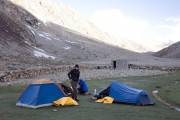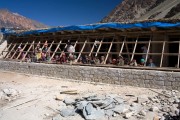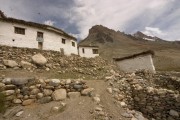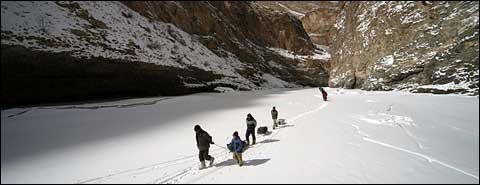Himalayan rivers have frozen - the Surya Team sets off across the Chadar
Even the Himalayas themselves have suffered from this freak winter. Only a few days ago it seemed that the river would not freeze, however, the situation changed enabling a group from the Surya Civic Association to set off on their journey across the Chadar ice flows. Setting off from Kargil, where they waited in vain for a helicopter, they finally managed to get to the timber in Ichar village so its transportation to Kurgyak could start.
"When the promised helicopter was still not coming, we decided to try another way - the crossing of the Pangsi-La gap, 4000 metres above sea level," said Honza Tilinger when describing the trek through the Padum village on the way to the stored timber in Ichar. "As we were getting closer to the end of the road under the pad by jeep, we started to realise it will not be so easy. We were sent back by police saying it was -35 °C with strong winds and six feet of snow in places. They even wanted us to tell them who advised us to do such a silly thing."
Finally, the team gave up and set off to go back along the road to the Ladhak capital Leh. They did so because they were told the rivers had started to freeze. That would mean they would be able to get to Padum by crossing the ice and wouldn't need to wait for the helicopter to arrive or the snow in Pangsi-La to melt. Jara Pechacek recorded in his diary under last Monday: "We hung up the lungta - the prayer flags - and prayed for the ice to hold firm. If it is true what people say, the journey to Padum will take us from three to four days. There are ice bumps even in Mogul meaning the conditions for Chadar should be ideal."
The next day they set off on a two and a half day journey across the frozen river accompanied by Chospel (a Sherpa). They slept overnight in caves whilst the temperature reached -25 °C. They recorded temperatures of -5 down to -8 °C during the day. When walking across the Chadar the camera and even the photographer himself stopped working, however, after having a day of rest when arriving in Padum, they both managed to pull together respectably.
Dorje and Spalgon, the inhabitants of Kurgyak, were already waiting for them there and together they set off heading to Ichar to get the timber. What would have been a two hour jeep ride up the hill, took them the whole day to walk because of the 20 to 30 feet of snow in places. The person who enjoyed walking most was a member of the Surya Team, Tenam, a Tibetian teacher, who was relishing immensely his first ever (and brand new) hiking boots that he had received from the sponsors of the Surya Team. "He was speeding up and down like mad," said Honza describing the snow-drift journey.
Meantime in Ichar, the destination of the team, the timber was already ready and waiting. The villages made a deal; Ichar would carry the timber for the first half of the journey and the people of Kurgyak would cover the second. By now approximately 90% of beams should have reached Kurgyak safely. In total, there were 67 beams that had to be brought over. Each of them needing to be carried by around nine strong men. The transport costs as much as the timber itself, 100,000 Indian rupees. On the Chadar ice from Ichar to Kargyak, there were 28 villagers working, each of them was paid 270 rupees per day.
The Surya Team will return to Kurgyak after five winter months. They will be certainly warmly welcomed by barley beer and goulash made from yak meat. The latest village news from Dorje and Spalgon is exceedingly positive. The greenhouse built by Czech volunteers last summer has already produced three harvests of spinach and one of radishes and coriander!

 In now days are hppening big changes in Jammu and Kashmir.
https://www.bbc.com/news/world/asia/india
In now days are hppening big changes in Jammu and Kashmir.
https://www.bbc.com/news/world/asia/india  On September 21st, Kargyak Sun School will celebrate the 10th anniversary of its opening. There, in one of the last places on Earth, the original Tibetan culture survives at the elevation of 4200 m. Before the school opened, the village of 200 heads had only 10 members who could read and write a little. To get an education, children were sent away to boarding schools in faraway towns. Today, the Sun School has its alumni and thanks to the project, people stopped moving away from the village.
On September 21st, Kargyak Sun School will celebrate the 10th anniversary of its opening. There, in one of the last places on Earth, the original Tibetan culture survives at the elevation of 4200 m. Before the school opened, the village of 200 heads had only 10 members who could read and write a little. To get an education, children were sent away to boarding schools in faraway towns. Today, the Sun School has its alumni and thanks to the project, people stopped moving away from the village.  PRAHA 22.11.2018 | 19:00 Betlémská kaple
BRNO 21.11.2018 | 19:00 Milosrdní bratři
PRAHA 22.11.2018 | 19:00 Betlémská kaple
BRNO 21.11.2018 | 19:00 Milosrdní bratři 



